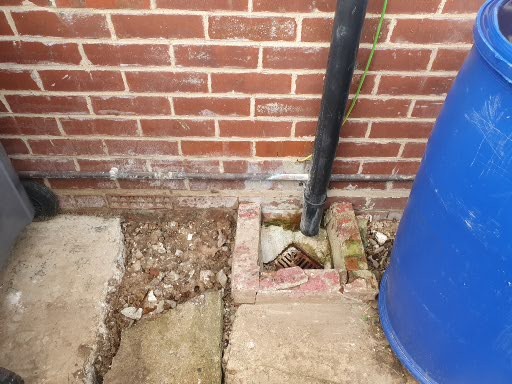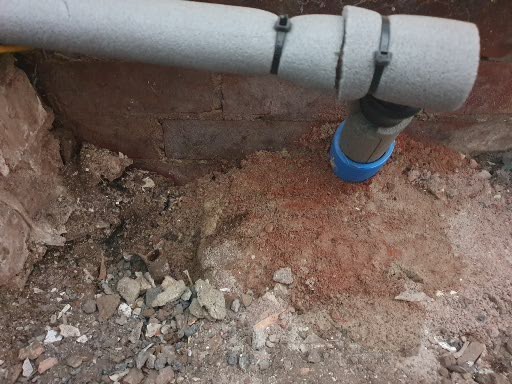
Joss
Members-
Posts
17 -
Joined
Recent Profile Visitors
The recent visitors block is disabled and is not being shown to other users.
Joss's Achievements

Member (3/5)
2
Reputation
-
Thanks for your replies. I will check with the installer whether pipe and ducting are sealed. Water does not splash out of the brick surround on the drain, but I think is probably getting between the mortar and wall sometimes. What is the best way to ensure that it goes down into the drain better?
-
Not sure if it is significant, but there is a down pipe outside, off to one side of the damp patch. The underground drain comes away from the house at an angle (off to left of photo). It is not blocked.
-
Ground level inside is 3 bricks below damp course, ground level outside is currently only 1 brick below damp course (plan to lower this later this year), so ground level inside is about 6 inches below ground level outside.
-
We have recently had a new water supply pipe installed. Where it comes into the house, there is a wet patch. Two weeks later, and it shows no signs of drying out despite not having a floor in that room and plenty of ventilation. Is it the sort of thing that might take months to dry? Would I be alright to insulate and replace the suspended timber floor, or should I leave it open longer?
-
A friend went on an open day to the pumping station, it extracts water from an underground chalk aquifer to supply drinking water to Folkestone, Dover and district. Have you tried asking a water treatment supplier if they have had had previous job with similar restrictions in place? They may have some idea who to contact / how to show that discharge from a water treatment plant is not hazardous to local water supply.
-
We use a bit of 4x4 timber cut 2 inches tall with a strip of felt glued on the sides. Placed on the floor, it can be moved for easy cleaning and is very unobtrusive. Also suggest looking at beanbag door stops too.
-
Just been buzzed by a mosquito.
Joss replied to epsilonGreedy's topic in General Self Build & DIY Discussion
-
Get one - you won't regret it. We have a bosch battery strimmer which has worked with no problems for several years. Different batteries to the power tools, so that they can't be borrowed.
-
We have rainwater storage of about 10000 litres for the garden (IBC's). This lasts us for around 3 months with no rain during the growing season for a large veg plot. We rarely go longer than this without a top up. As Bitpipe says, you can collect a useful amount in a short space of time. We use gravity and watering cans to deliver the water where it's needed.
-
Thanks for your replies. The plans show 'White upvc doors and windows to match existing'. I haven't specified a particular profile, frame width or anything like that, not that I know about anyway. I will check. { I didn't know of other options when the plans were being drawn up). No samples were required. So I don't think I'll worry too much about trying to find something exactly the same.
-
I am struggling a bit with planning language: The planning permission says that 'The materials to be used in the construction of the external surfaces of the development hereby permitted shall match those used on the existing building.' Hopefully someone can clarify what this actually means on our build, particularly regarding the windows. I am planning a loft conversion over a 1970's extension, at the rear of a 1930's bungalow, with a variety of windows of different styles and ages, and replaced at different times, but currently all with upvc double glazing. So, for the new windows, can I choose any upvc window to 'match' with the existing unmatched windows? For example, could I choose some with a slimmer frame? Another question I have is that if I were to replace the rear facing windows (they are particularly poor quality) with a different material eg alu clad timber, (allowed under permitted development) would I still need to use upvc for the new ones as specified, or would I be able to match with the new ones? Or would I have to go back to the planner and ask? Do the planners come to check what you have used, or do they rely on building control for this, or do they get involved only if someone reports a problem to them?
-
Thanks JSH for your very clear explanation. Splitting these as you have described is just what I was hoping to be able to do.
-
I am planning a bungalow loft conversion, and want a bathroom on the new first floor. At the same time, I am splitting an existing ground floor bedroom into two to make a new bathroom and cloakroom/wetroom. Existing bathroom to be removed (to make way for the stairs) I have had some building control drawings done which show a new soil vent pipe up through the roof. It was suggested in a previous post that I could perhaps have an air admittance valve inside the building instead, but that I would need a soil vent pipe outside the building too. I have read the part H building regs that relate to drainage and waste disposal, but am still not certain whether the existing soil vent pipe would be sufficient. If it is, would it need to be extended above the height of the new upstairs bathroom, and does it matter if it is upstream or downstream of the new drain connection. (mains drainage). Thanks for any help.
-
Kent - yes, lad - no ! A few miles south of you, nearest town is Dover. Thanks to everyone for your replies. I'm off to do some more reading, and will no doubt be back with some other questions soon.
-
Thanks for the welcome Dave, it makes more sense to me to have the eaves within the heated space, so that services are easier to access and don't make so many holes in insulation layer. I try not to have too much stuff to store, but space may be useful. Moving out would be difficult, we weren't planning to. We will need to discuss with the builder when we get that far. Ferdinand, I love the idea of teacosy. However the technician has included 3 separate 100mm extraction vents and a new soil vent pipe through the roof. Also mention of trickle vents on windows, so I am thinking I will end up with more of a sieve unless I can avoid all these and still keep within the regs. MVHR is looking more attractive, but it does seem very bulky and expensive. Mark, on my plans, the ashlar walls are stud walls made of timber, which I think are to hold up the existing roof structure. No ashlar stone anywhere near - no great features about our house. I appreciate the comments.





